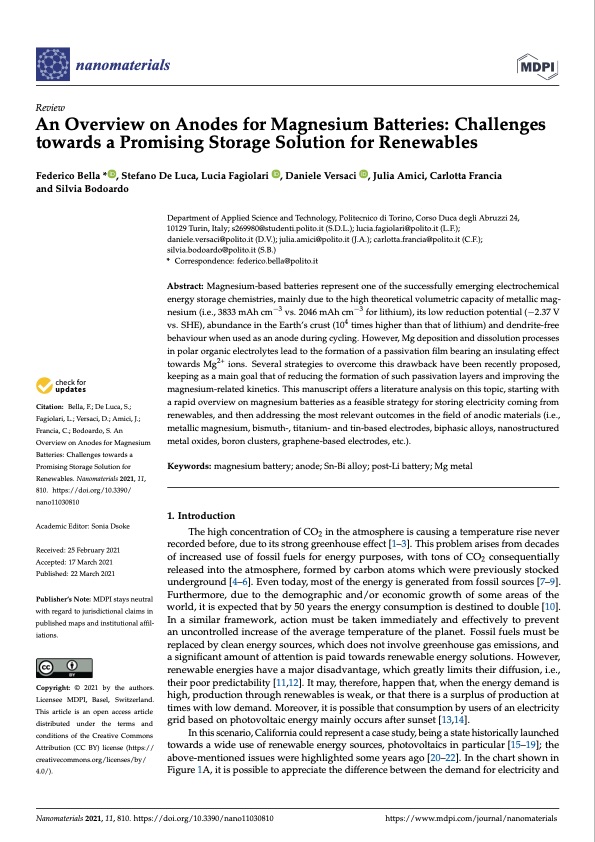
PDF Publication Title:
Text from PDF Page: 001
nanomaterials Review An Overview on Anodes for Magnesium Batteries: Challenges towards a Promising Storage Solution for Renewables Federico Bella * , Stefano De Luca, Lucia Fagiolari , Daniele Versaci , Julia Amici, Carlotta Francia and Silvia Bodoardo Citation: Bella,F.;DeLuca,S.; Fagiolari, L.; Versaci, D.; Amici, J.; Francia, C.; Bodoardo, S. An Overview on Anodes for Magnesium Batteries: Challenges towards a Promising Storage Solution for Renewables. Nanomaterials 2021, 11, 810. https://doi.org/10.3390/ nano11030810 Academic Editor: Sonia Dsoke Received: 25 February 2021 Accepted: 17 March 2021 Published: 22 March 2021 Publisher’s Note: MDPI stays neutral with regard to jurisdictional claims in published maps and institutional affil- iations. Copyright: © 2021 by the authors. Licensee MDPI, Basel, Switzerland. This article is an open access article distributed under the terms and conditions of the Creative Commons Attribution (CC BY) license (https:// creativecommons.org/licenses/by/ 4.0/). Department of Applied Science and Technology, Politecnico di Torino, Corso Duca degli Abruzzi 24, 10129 Turin, Italy; s269980@studenti.polito.it (S.D.L.); lucia.fagiolari@polito.it (L.F.); daniele.versaci@polito.it (D.V.); julia.amici@polito.it (J.A.); carlotta.francia@polito.it (C.F.); silvia.bodoardo@polito.it (S.B.) * Correspondence: federico.bella@polito.it Abstract: Magnesium-based batteries represent one of the successfully emerging electrochemical energy storage chemistries, mainly due to the high theoretical volumetric capacity of metallic mag- nesium (i.e., 3833 mAh cm−3 vs. 2046 mAh cm−3 for lithium), its low reduction potential (−2.37 V vs. SHE), abundance in the Earth’s crust (104 times higher than that of lithium) and dendrite-free behaviour when used as an anode during cycling. However, Mg deposition and dissolution processes in polar organic electrolytes lead to the formation of a passivation film bearing an insulating effect towards Mg2+ ions. Several strategies to overcome this drawback have been recently proposed, keeping as a main goal that of reducing the formation of such passivation layers and improving the magnesium-related kinetics. This manuscript offers a literature analysis on this topic, starting with a rapid overview on magnesium batteries as a feasible strategy for storing electricity coming from renewables, and then addressing the most relevant outcomes in the field of anodic materials (i.e., metallic magnesium, bismuth-, titanium- and tin-based electrodes, biphasic alloys, nanostructured metal oxides, boron clusters, graphene-based electrodes, etc.). Keywords: magnesium battery; anode; Sn-Bi alloy; post-Li battery; Mg metal 1. Introduction The high concentration of CO2 in the atmosphere is causing a temperature rise never recorded before, due to its strong greenhouse effect [1–3]. This problem arises from decades of increased use of fossil fuels for energy purposes, with tons of CO2 consequentially released into the atmosphere, formed by carbon atoms which were previously stocked underground [4–6]. Even today, most of the energy is generated from fossil sources [7–9]. Furthermore, due to the demographic and/or economic growth of some areas of the world, it is expected that by 50 years the energy consumption is destined to double [10]. In a similar framework, action must be taken immediately and effectively to prevent an uncontrolled increase of the average temperature of the planet. Fossil fuels must be replaced by clean energy sources, which does not involve greenhouse gas emissions, and a significant amount of attention is paid towards renewable energy solutions. However, renewable energies have a major disadvantage, which greatly limits their diffusion, i.e., their poor predictability [11,12]. It may, therefore, happen that, when the energy demand is high, production through renewables is weak, or that there is a surplus of production at times with low demand. Moreover, it is possible that consumption by users of an electricity grid based on photovoltaic energy mainly occurs after sunset [13,14]. In this scenario, California could represent a case study, being a state historically launched towards a wide use of renewable energy sources, photovoltaics in particular [15–19]; the above-mentioned issues were highlighted some years ago [20–22]. In the chart shown in Figure 1A, it is possible to appreciate the difference between the demand for electricity and Nanomaterials 2021, 11, 810. https://doi.org/10.3390/nano11030810 https://www.mdpi.com/journal/nanomaterialsPDF Image | Overview on Anodes for Magnesium Batteries

PDF Search Title:
Overview on Anodes for Magnesium BatteriesOriginal File Name Searched:
nanomaterials-11-00810.pdfDIY PDF Search: Google It | Yahoo | Bing
Product and Development Focus for Salgenx
Redox Flow Battery Technology: With the advent of the new USA tax credits for producing and selling batteries ($35/kW) we are focussing on a simple flow battery using shipping containers as the modular electrolyte storage units with tax credits up to $140,000 per system. Our main focus is on the salt battery. This battery can be used for both thermal and electrical storage applications. We call it the Cogeneration Battery or Cogen Battery. One project is converting salt (brine) based water conditioners to simultaneously produce power. In addition, there are many opportunities to extract Lithium from brine (salt lakes, groundwater, and producer water).Salt water or brine are huge sources for lithium. Most of the worlds lithium is acquired from a brine source. It's even in seawater in a low concentration. Brine is also a byproduct of huge powerplants, which can now use that as an electrolyte and a huge flow battery (which allows storage at the source).We welcome any business and equipment inquiries, as well as licensing our flow battery manufacturing.| CONTACT TEL: 608-238-6001 Email: greg@salgenx.com | RSS | AMP |